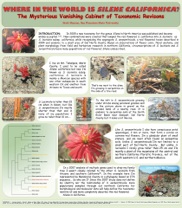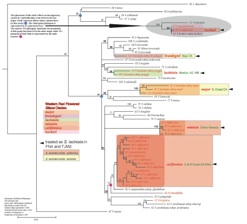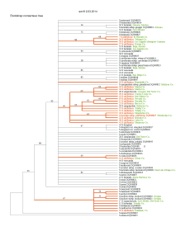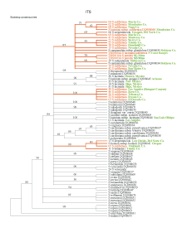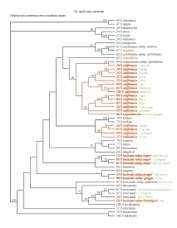
SCOTT SIMONO
Morphological, Cytological, and Molecular Evidence for Redefining the Identity of Red Flowered Silene (Caryophyllaceae) in California
Presented at the 2013 and 2014 Northern California Botanists Symposiums
In 2005 a new taxonomy for Silene was published in The Flora of North America(9) and Silene in the 2nd edition of The Jepson Manual(1) is based on this treatment. Both split what was known as S. californica, a showy red flowered Silene of northern California, into two entities. One, S. laciniata subsp. californica, became a subspecies of a mainly Mexican and southern Californian taxon and includes most of what was treated as S. californica. The other, S. serpentinicola, is described from populations endemic to serpentine soils near Gasquet in the Smith River Basin, Del Norte County, California(11), and listed as endangered by the California Native Plant Society (rank 1B.2). The northern California S. laciniata subsp. californica is differentiated from the southern California subspecies, S. laciniata subsp. laciniata, by having a 1-3 flowered, seldom branched inflorescence, and variations in leaf, capsule, and fruiting calyces shape. Silene laciniata subsp. californica resembles S. serpentinicola in these characters to a greater degree than it does S. laciniata subsp. laciniata(8). Besides a limited distribution, S. serpentinicola is differentiated from S. laciniata by a smaller stature (< 15 cm vs. > 20 cm), corolla color (carmine red vs. scarlet red), coronal petal appendages (conspicuous vs. inconspicuous), pubescence (densely vs. sparsely glandular), different ploidy counts (2n = 72 vs. 2n = 48, 72 or 96), and serpentine endemism(5,7,9,11). However, many populations of red flowered Silene throughout northern California share these characters. To further complicate things, various historic floristic treatments and monographs of Silene have differed in their definition and description of these characters(2,3,4,6,9,10,11,14). My review of herbarium specimens and measurements of plants in the field reveal populations that are inconsistently accounted for in the past and not described at all by any current account based on the new taxonomy.
In a recent study, four nuclear and two chloroplast DNA sequences were used to infer origins and phylogenetic relationships of the mostly polyploid North American Silene, including representatives from most of the California taxa recognized in the Flora of North America(12). No evidence for a relationship between S. laciniata subsp. californica and the other subspecies of S. laciniata was found. However, it was shown that many California Silene are allopolyploid species that likely formed recurrently from separate hybridization events. Since only one population was used to represent S. laciniata subsp. californica, and S. serpentinicola was not included, nothing could be inferred about the identities and relationships of populations with in this red flowered group.
Thus most of the former Silene californica populations are orphaned; their identity and relationships remain undescribed. Furthermore, these plants may represent unique populations or taxa in need of recognition and protection. The goal of this project is to define the identity of these Silene, including S. serpentinicola, in northern California with data collected from field, greenhouse, cytological, and molecular investigations. Fieldwork, which has already begun, will involve visiting populations of red flowered Silene, identified from herbarium records and the literature or by previous field exploration. Morphological characters will be measured, including characters used in distinguishing taxa in previous treatments. Seed has been or will be collected from representative populations and will be grown up to assess traits possibly related to environmental conditions. Because the multiple ploidy levels reported for S. laciniata subsp. californica (the former S. californica) also suggest different evolutionary lineages(12,13), these plants will also be used for chromosome counts for each population. Specimens will be vouchered and sampled for DNA. The six genes used in the previous study will be sequenced and combined with the larger data set from that research and analyzed to assess evolutionary and taxonomic relationships (see figure).
The data from this research will be used to generate a more inclusive description and key for the complex of red flowered Silene in California, to update and publish a new taxonomy where possible that reflects the information obtained from this endeavor, and provide a basis for a review of the protection status for these plants. Because California Silene species are polyploid, it is possible that different populations of a species, and even different members of a population, represent separate evolutionary lineages(13). This study will add to the description of natural examples of allopolyloid plant lineages which are redefining views on hybrid speciation and polyploidy, species concepts, and evolution.
Click on image to view posters (use browsers back button to return):
Introduction 2013 Results to date 2014
rps16 (chloroplast) phylogeny ITS (nuclear) phylogeny Max. Parsimony with bootstrap
concatenated (ITS, rps16, petL)
Maximum Likelihood Phylogeny, 3 genes concatenated
1 nuclear (ITS) and 2 chloroplast (rps16, petL)
ITS_PhyML.pdf ITS rps 16 PhyML MEGA tree.pdf ITS_petL_ML.pdf
Literature Cited
1 Hartman, Ronald L., Richard K. Rabeler and Dieter Wilken. 2012. Silene. In: Bruce
Baldwin (Ed.) The Jepson Manual, Vascular Plants of California, 2nd edition.
University of California Press, Berkeley, California: 616-622.
2 Hitchcock, C. Leo and Basset Maguire. 1947. A Revision of the North American Species
of Silene. In: University of Washington Publications in Biology, 13: 1-73.
3 Jepson, Willis Linn. 1914. A Flora of California. University of California, Berkeley.
Cunningham, Curtis and Welch, San Francisco. 1(5): 500-511.
4 Kruckeberg, A.R. 1954. Chromosome Numbers in Silene (Caryophyllaceae): I. Madrono,
12: 238-246.
5 Kruckeberg, A.R. 1957. Interspecific Hybridizations of Silene. American Journal of
Botany, 42: 373-378.
6 Kruckeberg, A.R. . 1960. Chromosome Numbers in Silene (Caryophyllaceae): II.
Madrono, 15: 205-215.
7 Kruckeberg, A.R. 1961. Artificial Crosses of Western North American Silenes. Brittonia,
13(4): 305-333.
8 Morton, J.K. 2004. New Combinations In North American Caryophyllaceae. Sida,
Contributions to Botany. BRIT, Fort Worth Texas. 21. (2): 887-888.
9 Morton, J.K. 2005. Silene. In: Flora of North America Editorial Committee, eds. 1993+.
Flora of North America North of Mexico. 16+ vols. New York and Oxford. Vol. 5:
166-214.
10 Munz, Philip A. 1968. A California Flora And Supplement. University of California
Press, Berkeley, California: 285-292.
11 Nelson, Thomas W. and Jane P. Nelson. 2004. A New Species of Silene
(Caryophyllaceae) from the Serpentines of Del Norte County, California. Madrono,
51(4): 384-386.
12 Popp, Magnus and Bengt Oxelman. 2007. Origin and Evolution of North American
Polyploid Silene (Caryophyllaceae). American Journal of Botany, 94(3): 330-349.
13 Soltis, Douglas E. and Pamela Soltis. 1999. Polyploidy: Recurrent Formation and Genome Evolution.
1Tree, 14(9): 348-352.
14 Wilken, Dieter. 1993. Silene. In: James C. Hickman (Ed.) The Jepson Manual, Higher
Plants of California. University of California Press, Berkeley, California: 488-493.
